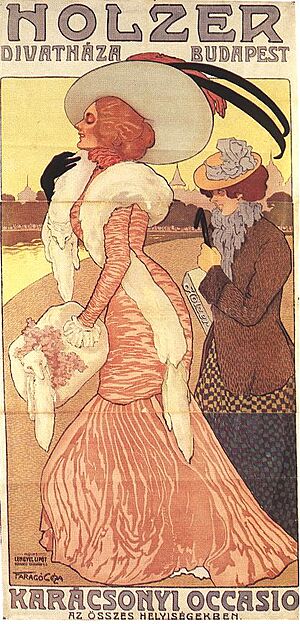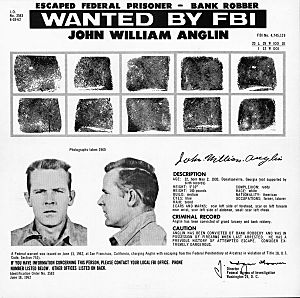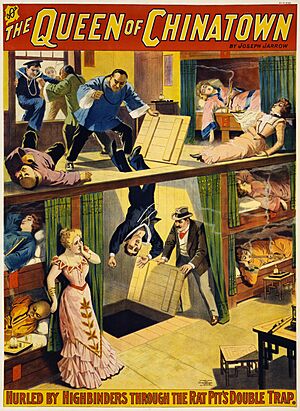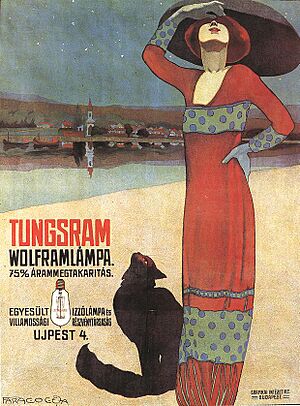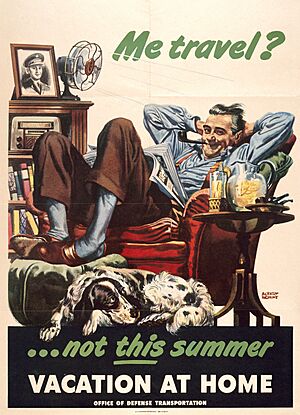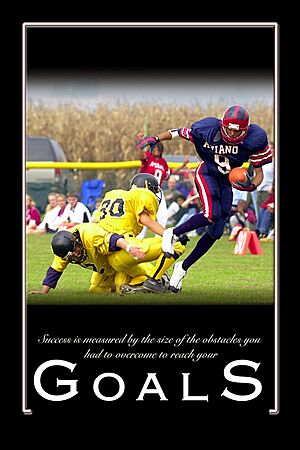Poster facts for kids
A poster is a large piece of paper or material. It is usually put up in public places to share a message or on a wall as decoration. Posters often have both words and pictures. They are made to grab your attention and give you information quickly. People use posters for many reasons. Advertisers use them to promote events, music, or movies. Groups trying to share a message, like for a protest, also use them. Posters can also be copies of famous artworks, which are usually much cheaper than the original art. The posters we see today became popular in the 1840s and 1850s. This was when new printing methods made it possible to create many colorful posters at once.
Contents
History of Posters
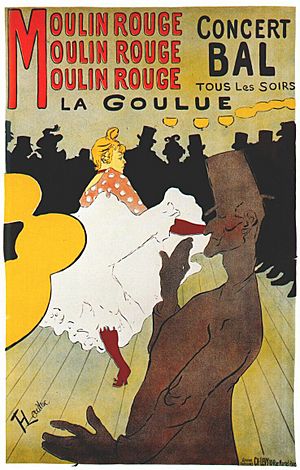
How Posters Began
For over 200 years, posters have been displayed all over the world. They are designed to catch the eye of people walking by. Posters can tell us about a political idea, invite us to events, or encourage us to buy something. The modern poster started in the mid-1800s. This happened because of three main changes. First, printing became much better, allowing many colorful and cheap images to be made. Second, governments in some countries, like France, allowed more freedom for public displays. Third, businesses started using posters to sell new products to more people in cities.
Experts say that in just over 100 years, posters became a very important art form. Many artists, from famous painters like Henri de Toulouse-Lautrec to designers, created posters. Posters have been made in many different art styles. These include Art Nouveau, Cubism, and Art Deco.
Making Many Posters at Once
Posters have been used for a very long time, mainly for advertising and announcements. For centuries, posters with just text announced plays by William Shakespeare. They also told citizens about government rules. The biggest change for posters was the invention of printing methods that allowed them to be made cheaply and in large numbers. One important method was lithography, invented in 1796. Soon after, chromolithography was developed. This allowed posters to be printed with bright, colorful pictures.
Posters as Art
By the 1890s, this new printing method was used all over Europe. Many famous French artists started creating poster art. Jules Chéret is often called the "father" of advertising posters. He started a small printing office in Paris in 1866. Chéret used bold characters, strong contrasts, and bright colors. He created over 1,000 advertisements, mostly for shows, theaters, and products. Many artists who needed money started designing posters.
Chéret made a new lithographic technique that was better for advertisers. He added much more color and new ways of writing words. This made posters much more expressive. Chéret also used images of smiling women, often called "chérettes," in his ads. This was a new idea of how art could help advertising.
Soon, posters changed the streets of Paris. One person at the time called the streets "the poor man's picture gallery." Posters became so successful that some fine artists seriously started designing them. Artists like Alphonse Mucha were very popular. Theater stars would even choose their favorite artist to make the poster for their next show. Poster art was so popular that a big exhibition was held in Paris in 1884.
The Golden Age of Posters
By the 1890s, posters were used widely across Europe. They advertised everything from bicycles to bullfights. By the end of the 19th century, during a time called the Belle Époque, posters were seen as a serious art form. Between 1895 and 1900, Jules Chéret created the Maîtres de l'Affiche series. This was a collection of important posters that became very successful.
Eugène Grasset and Alphonse Mucha were also important poster designers of this time. They were known for their Art Nouveau style and their elegant drawings, especially of women. Advertising posters became a special type of art in the modern age. Poster artists like Théophile Steinlen and Leonetto Cappiello became famous. Their art was used in magazines for advertising and for sharing social or political ideas. As one historian noted, when large, colorful posters appeared on public streets, they gained a new level of respect.
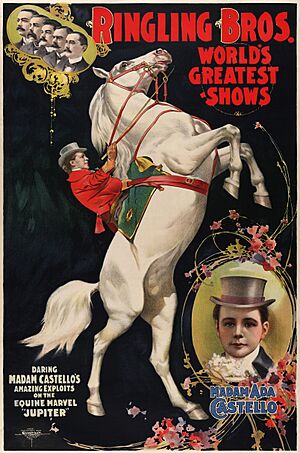
In the United States, posters developed a bit differently. By the 1850s, traveling circuses used colorful posters to announce their arrival in town. Many of these early posters were printed using woodcuts. While they were bright and busy, critics sometimes made fun of them. As colorful chromolithography changed European posters, American artists also started using this method more seriously. The work of designers like Edward Penfield became popular in both Europe and America.
Posters: Then and Now
After the First World War, posters became less important as a main way to advertise. Newer forms of advertising, like magazines, radio, and later television, took over. While posters were still made, they were no longer the main way businesses advertised. Instead, posters were used more for political messages and for decoration.
However, in the mid-1960s, posters became popular again. This was part of a larger cultural change. Some people called this a "second golden age" for posters. During this time, posters were used for decoration and self-expression as much as for protests or advertising.
What are Posters Used For?
By the 1890s, posters were used widely in Europe to advertise many things. Many posters have great artistic merit. This includes posters for products, entertainment, and big events like the World's Fair.
Posters for Politics and War
The first widespread use of illustrated posters for political reasons happened during the First World War. Posters encouraging people to buy war bonds and join the army replaced many commercial ads. Artists in Germany and for the Allied forces used their skills to help the war effort.
During the Second World War, the U.S. government distributed many posters. These were often displayed in post offices. Many posters explained why people needed to save supplies like gasoline and food.
The 1960s saw the rise of pop art and protest movements. Both used posters a lot, which helped make posters popular again. Some of the most famous posters were made by French students during the May 1968 protests. The famous poster of Che Guevara also became a symbol of rebellion for young people.
After the September 11 attacks in the United States, many public schools hung posters with "In God We Trust" in their libraries and classrooms.
Movie Posters
The film industry quickly learned that colorful posters were a great way to sell their films. Today, most major films have posters. Movie posters are very popular with collectors. A poster for the 1927 film Metropolis sold for $690,000 in 2005. Other old horror and science fiction movie posters can also sell for very high prices. The 1931 Frankenstein poster is thought to be the most valuable film poster in the world. Only one copy is known to exist.
Travel Posters
Posters are also made to advertise travel destinations or simply to show the beauty of a place. The "Beach Town Posters" series is a good example. These Art Deco travel posters from the 1920s and 1930s showed American beach resorts.
Railway Posters
In the early days of railways in Britain, train companies used simple posters to advertise their routes. By the 1850s, as printing improved, they started adding pictures to their posters. Artists began to design these pictorial posters. In 1905, the London and North Western Railway asked Norman Wilkinson to create a landscape poster. This poster advertised their train and boat link to Ireland. In 1908, John Hassall created the famous "Jolly Fisherman" image for the Great Northern Railway. This poster had the slogan "Skegness is so Bracing." Many artists created posters for railway companies. These posters showed changes in British society, art styles, and holiday trends.
Event Posters
Posters advertising events are very common. Any public event, from a rally to a play, might be advertised with posters. Some types of events are especially known for their posters.
Boxing Posters
Boxing posters were used around the fight venue to advertise the upcoming fight, date, and ticket prices. They usually showed pictures of each boxer. Old boxing posters are rare because few survived the event, making them valuable to collectors.
Concert Posters
Many concerts, especially rock concerts, have unique posters designed for them. These posters advertise the event and often become collector's items.
Music Group Posters
Posters featuring a person's favorite artist or music group are popular in teenagers' bedrooms and college dorm rooms. Many posters show popular rock bands and artists.
Motivational Posters
These are decorative posters meant to inspire and motivate people. One popular type has a black background, a nature scene, and a word like "Leadership" or "Opportunity."
Comic Book Posters
When comic books became popular again in the 1960s, many comic book posters were made. These posters usually show popular characters in action poses. Because comic books are a special market, fewer posters are printed for them. This means older comic book posters can be quite valuable to collectors.
Educational Posters
Classroom Posters
Posters are a common sight in classrooms around the world. A typical school might display many different kinds. These include posters related to history, alphabet and grammar charts, math and science tables, safety instructions (like for labs or hand washing), artwork, and posters made by students.
How Posters Are Made
Many printing methods are used to make posters. Most posters are mass-produced, meaning many copies are made. However, some posters are printed by hand or in limited numbers. Most posters are printed on one side and left blank on the back. This makes it easier to stick them to a wall. When you buy a poster, it is often rolled up into a tube to protect it during travel. You can flatten rolled-up posters by putting them under something heavy for a few hours.
You can also use special software to print large posters on regular home or office printers.
Collecting Posters
There are people who collect rare or old posters, much like people collect fine art. Popular types to collect include posters from the Belle Époque era, movies, war and propaganda, and travel. Because posters are usually not very expensive, there are fewer fake posters compared to other art forms. Organizations like the International Vintage Poster Dealers Association (IVPDA) help people find trusted poster dealers. Famous poster artists whose works are collected include Jules Chéret, Henri de Toulouse-Lautrec, and Alphonse Mucha.
See also
 In Spanish: Cartel para niños
In Spanish: Cartel para niños
- Graphic design
- Illustrations
- List of poster artists


